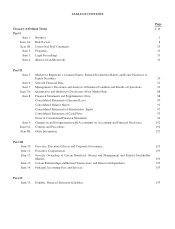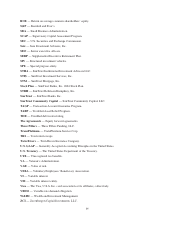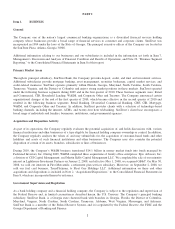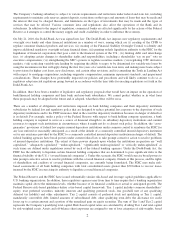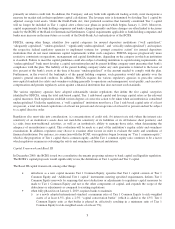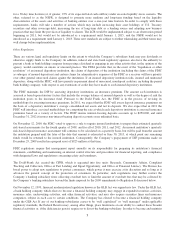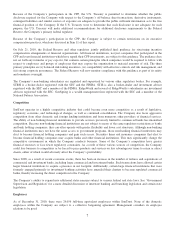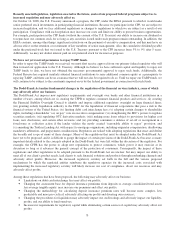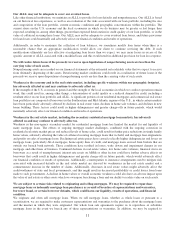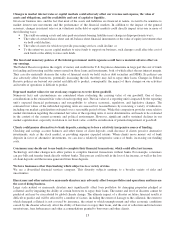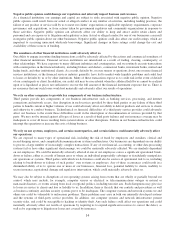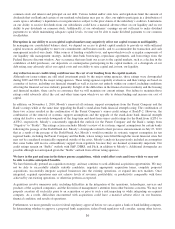SunTrust 2010 Annual Report Download - page 22
Download and view the complete annual report
Please find page 22 of the 2010 SunTrust annual report below. You can navigate through the pages in the report by either clicking on the pages listed below, or by using the keyword search tool below to find specific information within the annual report.its status as a financial holding company, the Company and all of its affiliated depository institutions must be “well-
capitalized,” “well-managed,” and have at least a satisfactory CRA rating. Furthermore, if the Federal Reserve determines
that a financial holding company has not maintained a satisfactory CRA rating, the Company will not be able to commence
any new financial activities or acquire a company that engages in such activities, although the Company will still be allowed
to engage in activities closely related to banking and make investments in the ordinary course of conducting merchant
banking activities.
Federal banking regulators, as required under the GLB Act, have adopted rules limiting the ability of banks and other
financial institutions to disclose nonpublic information about consumers to nonaffiliated third parties. The rules require
disclosure of privacy policies to consumers and, in some circumstances, allow consumers to prevent disclosure of certain
personal information to nonaffiliated third parties. The privacy provisions of the GLB Act affect how consumer information
is transmitted through diversified financial services companies and conveyed to outside vendors.
The Patriot Act substantially broadens existing anti-money laundering legislation and the extraterritorial jurisdiction of the
U.S.; imposes compliance and due diligence obligations; creates crimes and penalties; compels the production of documents
located both inside and outside the U.S., including those of non-U.S. institutions that have a correspondent relationship in the
U.S.; and clarifies the safe harbor from civil liability to clients. The U.S. Treasury has issued a number of regulations that
further clarify the Patriot Act’s requirements or provide more specific guidance on their application. The Patriot Act requires
all “financial institutions,” as defined, to establish certain anti-money laundering compliance and due diligence programs.
The Patriot Act requires financial institutions that maintain correspondent accounts for non-U.S. institutions, or persons that
are involved in private banking for “non-U.S. persons” or their representatives, to establish, “appropriate, specific and, where
necessary, enhanced due diligence policies, procedures, and controls that are reasonably designed to detect and report
instances of money laundering through those accounts.” Bank regulators are focusing their examinations on anti-money
laundering compliance, and we continue to enhance our anti-money laundering compliance programs.
In 2009, the Federal Reserve adopted amendments to its Regulation E that restricts our ability, beginning in July of 2010, to
charge our clients overdraft fees for ATM and everyday debit card transactions. Pursuant to the adopted regulation, clients
must opt-in to an overdraft service in order for the banking subsidiary to collect overdraft fees. Overdraft fees have in the
past represented a significant amount of noninterest fees collected by the Company’s banking subsidiary.
Pursuant to the Riegle-Neal Interstate Banking and Branching Efficiency Act of 1994, bank holding companies from any
state may acquire banks located in any other state, subject to certain conditions, including concentration limits. In addition, a
bank may establish branches across state lines by merging with a bank in another state, subject to certain restrictions. A bank
holding company may not directly or indirectly acquire ownership or control of more than 5% of the voting shares or
substantially all of the assets of any bank or merge or consolidate with another bank holding company without the prior
approval of the Federal Reserve. Under the recently enacted Dodd-Frank Act, a bank holding company may not acquire
another bank or engage in new activities that are financial in nature or acquire a non-bank company that engages in activities
that are financial in nature unless the bank holding company is both well capitalized and deemed by the Federal Reserve to
be well managed. Moreover, a bank and its affiliates may not, after the acquisition of another bank, control more than 10% of
the amount of deposits of insured depository institutions in the U.S. and a financial company may not merge, consolidate or
acquire another company if the total consolidated liabilities of the acquiring financial company after such acquisition exceeds
10% of the aggregated consolidated liabilities of all financial companies at the end of the year preceding the transaction. In
addition, certain states may have limitations on the amount of deposits any bank may hold within that state.
The Company is subject to the rules and regulations promulgated under the EESA by virtue of the Company’s sale of
preferred stock to the U.S. Treasury under the U.S. Treasury’s CPP. Additional information relating to the restrictions on
dividends and redemptions is included in the information set forth in Item 7 of this report under the caption, “Capital
Resources” and “Liquidity Risk.” Furthermore, under rules and regulations of EESA to which the Company is subject, no
dividends may be declared or paid on the Company’s common stock and the Company may not repurchase or redeem any
common stock unless dividends due with respect to Senior Preferred Shares have been paid in full. Moreover, the consent of
the U.S. Treasury will be required for any increase in the per share dividends on the Company’s common stock, beyond the
per share dividend declared prior to October 14, 2008 ($0.77 per share per quarter) until the third anniversary of the date of
U.S. Treasury’s investment; unless prior to the third anniversary, the Senior Preferred Shares are redeemed in whole or the
U.S. Treasury has transferred all of its shares to third parties. Under this provision, the Company could reduce its dividend
and subsequently restore it to no more than $0.77 per share per quarter at any time. Additionally, if the Company pays a
dividend in excess of $0.54 per share per quarter before the tenth anniversary then the anti-dilution provisions of the U.S.
Treasury’s warrants will reduce its exercise price and increase the number of shares issuable upon exercise of the warrant.
6


